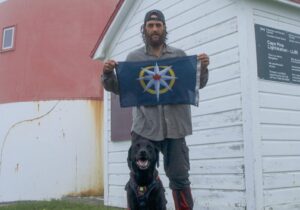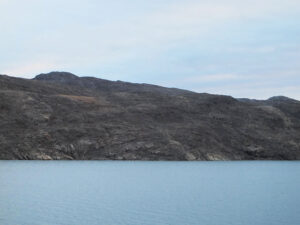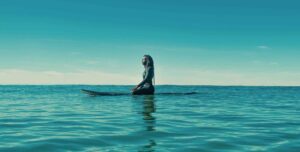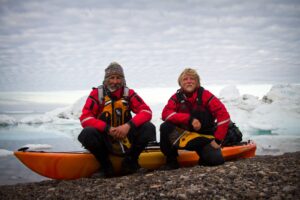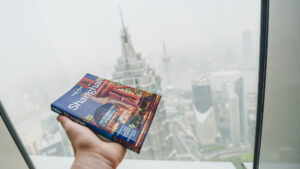A Journey from One End of the World to the Other
By Piotr Chmielinski
Three hundred and twelve days, two continents, fifteen countries, over 45,000 kilometers, and hundreds of hours behind the wheel – this is the summary of the journey of the WheelchairTrip of Michał Woroch and Maciej Kamiński. Two wheelchair-bound friends crossing the Americas in a twenty-two-year-old Land Rover Defender (Defe) had just reached their destination; they reached the other end of the world, Prudhoe Bay in Alaska.

Michał Woroch and Maciej Kamiński arrived on July 31, 2018 at Deadhorse / Prudhoe Bay in Alaska after 312 days of travel. Photo: Michał Woroch
“In can be very nice here”
The most important issue in the Alaska expedition was the timing. It was important not to get there too early, that is before the end of the winter, but not too late, that is before the winter starts again. August was the latest month to make it before the snow starts coming down, which creates difficulties in moving around the largest state of the United States.
So, when at the end of May Michał and Maciej picked up their favorite Defe from an auto service shop in Los Angeles with a freshly installed engine, they took it for a one thousand kilometer test drive. After they got to be positive that the car was in good working order; and they took off north of the continent. Looking at the map of their journey, one could get the impression that, after a year pause, both the driver and the car wanted to be constantly in motion. They quickly passed San Francisco, traveled through Oregon State and entered Washington State. Short breaks in the journey were filled with meetings, among others with Dawid Andres, the one who with his brother Hubert Kisiński biked the entire Amazon (see: https://explorersweb.com/?s=Biking+the+Amazon) then journalist and writer Joe Kane, author of the book “Running the Amazon”, friends Scott and Cristi Searls and my son, Max, who lives and studies in Seattle. From there, they headed across Canada to Alaska.

Michał Woroch (first from left) with friends at Polish Festival at Seattle Center. Photo. Arrow Trans Corp’s
– We crossed many borders during our trip, but these were always only lines on the map and little characteristic changes in the landscape – Michał answers my question about their first impressions of Alaska. – This time it was similar, the hundreds of kilometers driven in Canada allowed us to prepare for the climate of Alaska.
However, there was one difference. This time, it took them a little bit longer than usual to cross the border. And that was due to the border guard.
– He was interested in completely different things than guards on other borders – says Michał.
That friendly man in the uniform was intrigued by the expedition of two disabled Poles. He asked about the course of the journey, about the most difficult stages of it, about security and where the idea of our expedition came from. Especially, their Defe, and its hood decorated with hundreds of signatures written in gold letters caught his attention. He was pleased when they asked him to put his own golden signature. At the end he marked their passports with the souvenir stamps.
– Later we commented with Maciej, that since the guard has such peace and joy in his eyes, it could be very nice here in Alaska – says Michał.

Route number 11 (Dalton Highway) from Fairbanks to Deadhorse. Photo: Michał Woroch

Route number 11 (Dalton Highway) from Fairbanks to Deadhorse. Photo: Michał Woroch

Michał Woroch and Maciej Kamiński. Topping up oil and water in DEFE. Photo: Maciej Kamiński

Route number 11 (Dalton Highway) from Fairbanks to Deadhorse. Photo: Michał Woroch
The wasteland is not a picnic
Originally, Michał and Maciej planned first to go north to Fairbanks and from there to Prudhoe Bay. However, shortly after crossing the border, when checking their location on the map, I saw that they were heading straight for the state capital. I suspected that something must have happened. Well, I was right. Oil began to leak from Defe. Whatever oil they added it leaked out. They decided that it would be easier to find mechanics in Anchorage rather than in the wasteland. With the help of Sławek and Krystyna Markiewicz, they found a few repair workshops, but none of them wanted to even diagnose the problem in … such an old and worn out car.
So, Michał and Maciej bought a large supply of oil and hit the road again. They go and pour the oil and go, and pour more, and again add more of it. Interestingly, they noticed that the dirtier the car, the less oil leaked and the less often it needed to be added.
Once again, I forgot that during the trip, Michał and Maciej don’t like to be asked about their impressions from the road, what they saw, what sights they remembered. In case of both travelers I had noticed long ago that the images were registered, but they were processed only after some time. Then they return to them on the occasion or in association with current situations. Michał’s pictures are more “telling” what Alaska looks – raw landscape, empty spaces, mountains with the road wrapped around them. No houses, no settlements, no people in sight. Fascinating wildness, but also a lot of obstacles, which are a challenge for the travelers to overcome. It’s a bit like one of the characters in the book “Into the Wild” by Jon Krakauer said about people from outside, ”They’ll pick up a copy of Alaska Magazine, thumb through it, get to thinkin’ ‘Hey, I’m goin’ to get on up there, live off the land, go claim me a piece of the good life.’ But when they get here and actually head out into the bush-well, it isn’t like the magazines make it out to be. The rivers are big and fast. The mosquitos eat you alive. Most places, there are not a lot of animals to hunt. Livin’ in the bush isn’t no picnic.”
Alaska is usually associated with the historical purchase of this area from Russia by the US government in 1867, with the gold fever, which occurred there in 1896 and with Jack London, in particular with Buck, the dog hero from his book “The Call of the Wild”. Contemporary Alaska can still be associated with fever, but this time it is oil fever, since in Prudhoe Bay, rich deposits of oil and natural gas were discovered in 1969. The famous Trans-Alaska oil pipeline runs south from there and along it, the Dalton Highway, a road that is pretty nasty to travel on.
– The route from Fairbanks to Deadhorse was a demanding route. Eight hundred kilometers of uneven, mostly gravel roads. At the time we were driving, there was an increased traffic with many trucks. Transport companies try to carry out all the orders before the beginning of winter, which according to locals will come here very quickly. – said Michał. – With the rain, mud and our worn out tires in the three-ton Defender, which does not have any traction control systems, we felt like we were on the Dakar Rally. In addition, we killed millions of mosquitoes.
The other end of the world
In Deadhorse, Michał and Maciej fulfilled a goal of their trip. Unfortunately, they did not reach the Arctic Ocean, due to the fact that the oil fields are closely safeguarded and only buses with special permits can take travelers to the coast.
– It doesn’t matter anymore – says Michał. We’re here, almost at the end of the world, and we’re glad we did it.

Michał Woroch and Maciej Kamiński in Ushuaia, Argentina, 30 November, 2016. Photo. Michał Woroch


The friends traveled from one end of the world to the other in three hundred and twelve days. Writing these words, I wondered how it is that we write about the extremities of the world and never about the starting points, and where would this beginning be? In the case of Michał and Maciej, it could be found at one of those visited ends – in Ushuaia, Terra del Fuego, where the great inscription says that there it is “the end of the world, the beginning of everything”. For both friends it was the beginning of a great journey and a great adventure. They proved to themselves that they were able to overcome obstacles and deal with difficult, seemingly hopeless situations.- It was a very long journey – says Michał. – I am very happy, but also tired of this traveling.
In fact, that journey began in 2014, when the idea of going to South America and later North America was born. Two years of preparations, then the Buenos Aires – Los Angeles trip, next, an almost one-year break filled with meetings, presentations and organization of car repairs, and finally, the last stage from Los Angeles to Deadhorse, Alaska.- Achieving the intended goal is a BEAUTIFUL FEELING – Michał emphasizes.
The journey itself is not over yet
We still have about 8,000 kilometers ahead of us. We have to descend our summit – says Michał, who on many occasions called the goal of the WheelchairTrip(see: https://wheelchairtrip.com/index_en.html) as their K2. – We predict that it might take us two more months of driving through South Alaska, Canada, and then the US, where we will head southeast, towards Washington DC.
Previous stories:
https://explorersweb.com/2018/06/29/on-the-road-again-direction-alaska/
https://pythom.com/Alaska-must-wait-2017-08-02-54635
